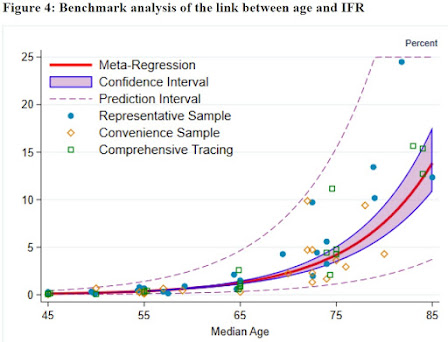It seems well-known that the health risks of COVID-19 are larger for the elderly. But how much larger? And what is the trajectory of risk across age?
Andrew T. Levin, William P. Hanage, Nana Owusu-Boaitey, Kensington B. Cochran, Seamus P. Walsh, Gideon Meyerowitz-Katz provide a set of estimates "Assessing the Age Specificity of Infection Fatality Rates for COVID-19: Meta-Analysis & Public Policy Implications" (NBER Working paper 27597, as revised October 2020, also available via medRxiv, which is a "preprint server for the health sciences").
Also, Andrew Levin is the genial and informative talking head in a 15-minute video discussing the main approach and results.
As the title implies, the paper is an effort to pull together evidence on the health effects of COVID-19 by age from a variety of sources. Two figures in particular caught my eye. This figure shows the "infection fatality rate"--that is, the the ratio of fatalities to total infections. The different kinds of dots on the figure show results from different kinds of studies. The red line is their central estimate, which is surrounded with estimates of the uncertainty involved.
As the authors write: "Evidently, the SARS-CoV-2 virus poses a substantial mortality risk for middle-aged adults and even higher risks for elderly people: The IFR is very low for children and young adults but rises to 0·4% at age 55, 1·3% at age 65, 4·2% at age 75, 14% at age 85, and exceeds 25% for ages 90 and above."
The COVID-19 risk for the elderly is clearly substantial. But how does one think about the risk for those, say, in the 45-65 age bracket. Their COVID-19 risk is clearly lower than for the 85 year-olds. But how does their COVID-19 risk compare with other everyday risks? In his talk, Levin offers a comparison with risks of death from an automobile crash by age.

One wouldn't want to pretend that this comparison literally apples-to-apples. For example, the risks of driving are somewhat under the control of the drive, while the risk of dying after being infected by COVID-19 is not. In addition, this is comparing the risks of dying after being infected, which applies to only a subset of the population, with the overall risk of driving for the entire population.
However, the comparison nonetheless seems quite useful to me, in the sense that many of us accept that driving a car has some risk, but it's a risk we take almost every day without excessive concern. Thus, seeing that for the average person under age 34, the COVID infection fatality rate is below the auto fatality rate gives a sense that for that age group taken as a whole (and of course with exceptions for a small number of people with certain pre-existing conditions), the personal risk of COVID-19 shouldn't bother them much.
Interpreting the risks of those in the age brackets from, say, 35-64 is a little trickier. The COVID-19 risk number for these age brackets do not look especially high in absolute terms, certainly not as compared to the risks for the 85+ group. But from another perspective, for the 45-54 group, the COVID-19 risk is something like 16 times the auto fatality risk; for the 55-64 group, the COVID-19 rise is more than 5000 times the auto fatality risk.
Most people, myself included, are not good at thinking about these kinds of small risks. If I take a risk that I think of as negligible, and multiply it by 16, does "16 x negligible" equal something I should worr about? Maybe "16 x negligible" is like the risk of driving home in the dark on a snowy day, which is a risk I think about, but not one that stops me from driving home.
But what about about "5,000 x negligible" for the 55-64 age group, of which I have the honor to be a member? Is that enough to do more than raise my eyebrows? For my age group, the risk of dying if I got COVID-19 is 0.7%. which is like saying 1 chance out of 143. There are a lot of contexts where I wouldn't pay much attention to 1 chance in 142. But if it's life and death, I'm willing to take some steps to reduce the risk of that outcome.
There are certain risks I don't take while driving, like driving with alcohol in my system. Granted, I don't take the risk of driving under the influence not so much because I fear I will kill myself, but because I fear accidents and, even worse, harming someone else. But if the COVID-19 danger to me is in some way comparable to driving while intoxicated, then consistency in thinking about risks suggests that I should make efforts to avoid being exposed to the disease--and also to avoid being a carrier to my wife or any other above-age-35 people with whom my life intersects.
To put it another way, many of us adjust our behavior in a variety of ways to reduce moderate health risks, like wearing a helmet while bicycling, or not driving in an unsafe manner, or throwing away food that seems to have spoiled in the refrigerator. The reduction in risk from these behavior may not be large in absolute terms, but they feel worth taking. In a similar sense, the health risks of COVID-19 for those in the 35-64 age group are probably not exceptionally high in absolute terms, but for many of us who act to reduce other risks in our lives, the COVID-19 risks are also high enough to justify efforts that will reduce those risks.
Of course, these sorts of comparisons are about averages, not at individuals who will be above- or below-average in various risks. But general public health guidance needs to be aimed at averages.





Leave your comments
Post comment as a guest